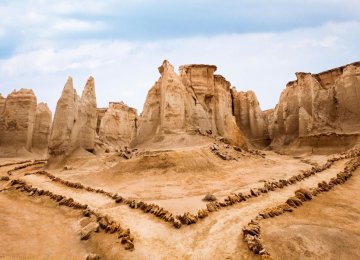Qeshm Island is a key destination in southern Iran, which draws tourists in droves every year.
Blessed with unique geological formations that host a variety of flora and fauna and sandy beaches kissed by the pristine waters of the Persian Gulf, the island is brimming with opportunities squandered due to a host of factors, according to travel bloggers who have recently visited the southern Iranian island.
A number of bloggers, some of whom had impressed the judges at a travel blogging competition organized by Qeshm tourism authorities two months ago, traveled to the island for four days and wrote about their experiences on their personal blogs, Donyaye-safar.com reported.
They all wrote about the island’s attractions, but they also wrote extensively about its shortcomings.
“The island is pushing for industrialization while at the same time trying to preserve its traditions, but the two clash—a clear example of unsustainable development in Qeshm,” wrote Muhammad Gaeini, who has made a habit of traveling to Qeshm. “Development or traditions, we can only choose one.”
Regaining Past Status
Qeshm is the Middle East’s first UNESCO-listed geopark, which lost its status a few years ago due to problems that have remained unresolved, such as underdeveloped infrastructure and unenforced environmental regulations.
Authorities are trying to bring the geopark back to global standards so it regains its international status, “but unrestrained construction of buildings, especially in areas whose geology is meant to remain untouched,” threatens to undo efforts to put the geopark back on UNESCO’s radar, he said.
Mehdi Goli, another blogger, says Qeshm “is an extraordinary place that revitalizes me every time I visit it,” but conceded that one of the island’s major problems is a lack of developed public transportation system.
“Not everyone can afford to pay the cabs’ hourly rates, but if the public transportation network could extend to areas where the island’s attractions are located, Qeshm may very well become a top destination for everyone, including families,” he wrote.
Qeshm authorities are aware that this glaring lack of infrastructure has overshadowed the island’s attractions, pulling tourists away from beaches and wildlife habitats, and pushing them into malls and shopping centers.
“Qeshm can only improve if it uses all it has to offer,” Goli added.
One of the island’s main attractions is its indigenous people and the vastly different lives they live, according to Mina Kamran, but the villages are so underdeveloped that travelers are deterred from visiting.
“I’ve always been fascinated with Qeshm’s villages. It’s nothing like we know about rural life,” she wrote on her blog. “But the villages lack the most basic infrastructure, such as public rest rooms and diners.”
Help From JICA
Qeshm Free Zone Organization is said to have enlisted the help of Japan International Cooperation Agency to help develop the island’s travel sector to draw more tourists, especially foreign.
In June 2015, Hamid Reza Momeni, managing director of QFZO, and Kohei Sato, chief representative of JICA’s Iran office, signed an agreement in Tehran to launch a joint project aimed at turning Qeshm into an “eco island resort” by pursuing sustainable development.
Based on the agreement, JICA will transfer its experience and knowledge to QFZO to help improve the quality of life of the locals and augment sustainability.
Last December, JICA launched an extensive study of four major investment areas in Qeshm, namely tourism, fishing, wastewater and solid waste management, with a special focus on environmental conservation.
Once successfully implemented, the JICA project is expected to increase household income through ecotourism, improve women’s social status through participation in economic activities, reduce the environmental impact of tourism and curb the negative effects of industrial development and population growth in the production of solid waste and wastewater.
Established in 1974, JICA aims to contribute to the promotion of international cooperation and sound development of Japanese and global economy by supporting the socioeconomic development, recovery or economic stability of underdeveloped regions.





